-
4.560 Billion Years Ago
 The planet Earth forms from the protoplanetary disk of dust grains and rocks attracting by the force of gravity at the outer edge of the habitable zone in the accretion disc revolving around the young Sun
The planet Earth forms from the protoplanetary disk of dust grains and rocks attracting by the force of gravity at the outer edge of the habitable zone in the accretion disc revolving around the young Sun -
4.533 Billion Years AgoPlanet Earth and the hypothesized protoplanet Theia collide sending large number of moonlets into orbit around the Earth which eventually coalesce to form the Moon
-
3.6 Billion Years Ago
 Prokaryotes, the first simple cells without nucleus and mitochondria, that use carbon dioxide as a carbon source and oxidize inorganic materials to extract energy, appear, probably in deep-sea thermal vents or atmosphere
Prokaryotes, the first simple cells without nucleus and mitochondria, that use carbon dioxide as a carbon source and oxidize inorganic materials to extract energy, appear, probably in deep-sea thermal vents or atmosphere -
2.9 Billion Years Ago
 Photosynthesizing cyanobacteria, which use water and carbon dioxide as a reducing agent and produce oxygen as waste product, evolve, creating the oxygen-rich atmosphere
Photosynthesizing cyanobacteria, which use water and carbon dioxide as a reducing agent and produce oxygen as waste product, evolve, creating the oxygen-rich atmosphere -
2.1 Billion Years Ago
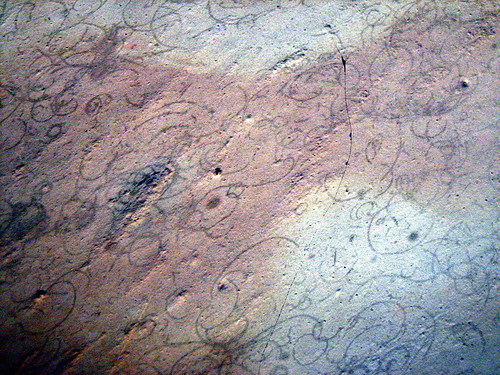 Eukaryotes, complex cells which contain nucleus enclosed within membranes, derive from prokaryotes via fusion of some cells and free-living bacteria, which become mitochondria and start providing energy to the cell by converting sugars
Eukaryotes, complex cells which contain nucleus enclosed within membranes, derive from prokaryotes via fusion of some cells and free-living bacteria, which become mitochondria and start providing energy to the cell by converting sugars -
1.2 Billion Years Ago
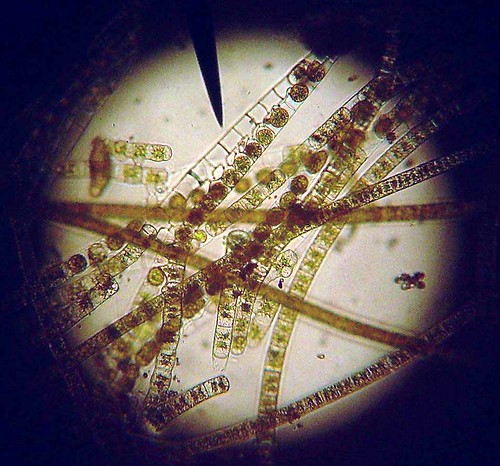 First simple multicellular organisms, mostly consisting of cell colonies of limited complexity, evolve independently in some groups of single cells, which allows organisms to exceed the size limits
First simple multicellular organisms, mostly consisting of cell colonies of limited complexity, evolve independently in some groups of single cells, which allows organisms to exceed the size limits -
580 Million Years AgoThe accumulation of atmospheric oxygen allows the formation of an ozone layer, which blocks ultraviolet radiation, permitting the colonisation of the land
-
540 Million Years Ago
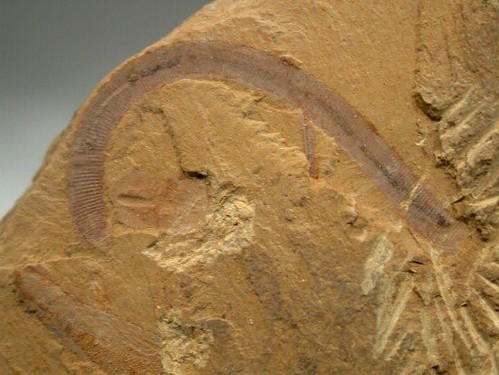 The Cambrian explosion, the relatively rapid, lasting 70 million years, appearance of most major animal phyla accompanied by major diversification of organisms, begins
The Cambrian explosion, the relatively rapid, lasting 70 million years, appearance of most major animal phyla accompanied by major diversification of organisms, begins -
435 Millions Years Ago
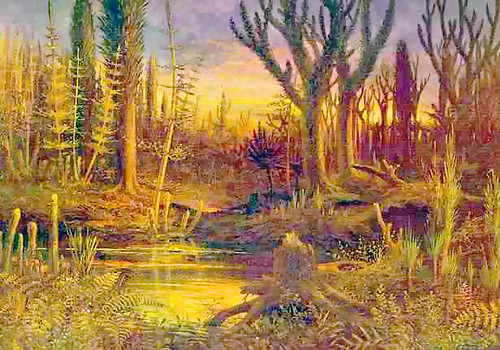 The first primitive plants move onto land and rapidly diversify, having evolved from green algae living along the edges of lakes
The first primitive plants move onto land and rapidly diversify, having evolved from green algae living along the edges of lakes -
365 Million Years Ago
 First amphibians, four-limbed backboned tetrapods, evolve from the lobe-finned fishes, gradually gaining adaptations, such as lungs and nares, which will help them occupy land and give rise to reptiles and mammals
First amphibians, four-limbed backboned tetrapods, evolve from the lobe-finned fishes, gradually gaining adaptations, such as lungs and nares, which will help them occupy land and give rise to reptiles and mammals -
320 Million Years Ago
 The first reptiles evolve from advanced reptiliomorph labyrinthodonts, a newt-like amphibians that gain scaly skin and begin laying eggs with hard shells outside the water
The first reptiles evolve from advanced reptiliomorph labyrinthodonts, a newt-like amphibians that gain scaly skin and begin laying eggs with hard shells outside the water -
220 Millions Years Ago
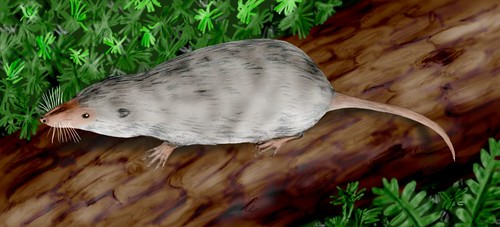 Adelobasileus, the first known mammal, which resembles modern rats and has sweat glands, including those that are specialized to produce milk to nourish their young, evolves from reptiles called cynodonts
Adelobasileus, the first known mammal, which resembles modern rats and has sweat glands, including those that are specialized to produce milk to nourish their young, evolves from reptiles called cynodonts -
200 Million Years AgoPangaea, the large supercontinent, begins to rift into two continents: Laurasia, which contains North America and Eurasia, and other supercontinent - Gondwana, containing Africa, South America, India, Antarctica, and Australia
-
199,6 Million Years Ago
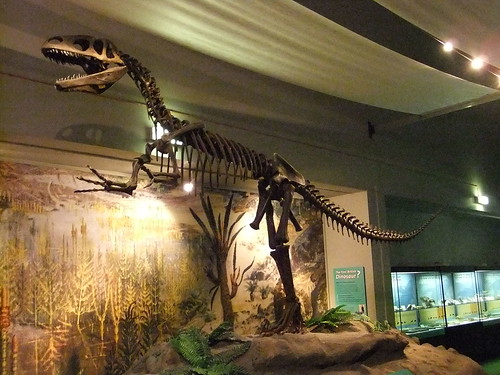 Triassic-Jurassic extinction event wipes out twenty percent of all marine families and all large non-dinosaurian archosaurs other than crocodilians on land, leaving the dinosaurs the dominant land animals
Triassic-Jurassic extinction event wipes out twenty percent of all marine families and all large non-dinosaurian archosaurs other than crocodilians on land, leaving the dinosaurs the dominant land animals -
155 Million Years Ago
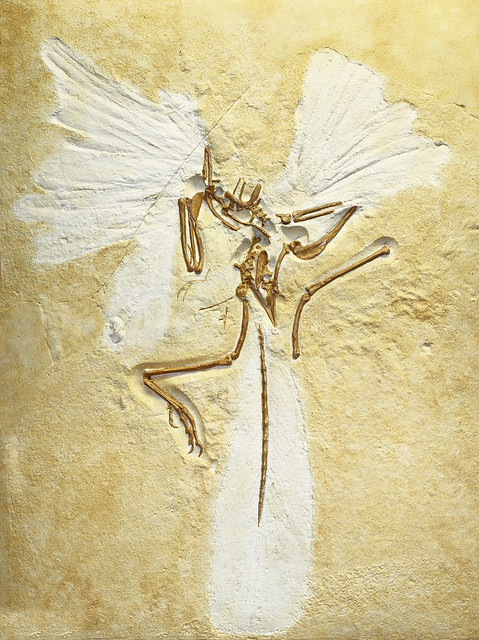 Archaeopteryx, one of the first birds and transitional fossil between feathered dinosaurs and modern birds, appears following evolution of some other early birds, such as Anchiornis and Aurornis
Archaeopteryx, one of the first birds and transitional fossil between feathered dinosaurs and modern birds, appears following evolution of some other early birds, such as Anchiornis and Aurornis -
130 Million Years Ago
 The first flowering plants, whose boast structures attract insects and other animals to spread pollen, which causes a major burst of animal evolution through co-evolution, appear
The first flowering plants, whose boast structures attract insects and other animals to spread pollen, which causes a major burst of animal evolution through co-evolution, appear -
65.5 Million Years Ago
 An asteroid 10 kilometers in diameter falls on the coast of Yucatán in Mexico and causes the Cretaceous–Paleogene extinction event with eradicating about half of all animal species, including the dinosaurs but excluding their descendants, the birds
An asteroid 10 kilometers in diameter falls on the coast of Yucatán in Mexico and causes the Cretaceous–Paleogene extinction event with eradicating about half of all animal species, including the dinosaurs but excluding their descendants, the birds -
65 Million Years Ago
 Purgatorius, a rat-sized placental mammal with mass about 40 grams, becomes the earliest example of a primate or a proto-primate, giving rise to monkeys, apes and humans
Purgatorius, a rat-sized placental mammal with mass about 40 grams, becomes the earliest example of a primate or a proto-primate, giving rise to monkeys, apes and humans -
2.5 Million Years Ago
 Homo habilis, the earliest known species of the genus Homo, evolves from Hominidae in East Africa, beginning usage of primitive stone tools for hunting and work
Homo habilis, the earliest known species of the genus Homo, evolves from Hominidae in East Africa, beginning usage of primitive stone tools for hunting and work -
200 Thousand Years Ago
 Anatomically modern human, who has more gracile frames, reduced brow ridges and vertical forehead, evolve from archaic Homo sapiens in East Africa
Anatomically modern human, who has more gracile frames, reduced brow ridges and vertical forehead, evolve from archaic Homo sapiens in East Africa
Monday, May 8, 2017
20 Most Important Events in Earth's History
Labels:
Archean,
Catastrophes,
Cells,
Eclipses,
Evolution,
Geology,
Hadean,
Kaapvaal Craton,
Mesoarchean,
Moon,
Paleoarchean,
Pilbara Craton,
Planets,
Precambrian,
Prokaryotes,
Solar Eclipses,
Supercontinents,
Theia,
Vaalbara
Sunday, April 2, 2017
4 Nice Blogs about History
Hi, dear readers. Today we want to post an extra post, in which we are going to share some information about sources where you can dig a bit of interesting information about different historical topics. Pay attention that all blogs are located on different platforms.
The first blog is hosted on Dreamwidth platform, which have simple design, but allows easily to add images and embedded elements. Here is an example of a nice blog that contains a lot of curious information. This blog is written by a friend of our, Alex Morz.
Of course, you know that the most popular blog platform in the Internet is Wordpress. There is also a very good account on Wordpress which we want to recommend. We have already shared with you a wonderful historical resource. It is a blog that posts information about this day in form of timeline every day. Enjoy reading every morning about the crucial moments occurred on the day.
Another blog platform is Weebly, which lets to experiment with design and easily combine a post full of media information. This is a wonderful example of a blog implemented on this platform. The blog explains information about very wide rage of topics: from Islam to Haiti Revolution.
The first blog is hosted on Dreamwidth platform, which have simple design, but allows easily to add images and embedded elements. Here is an example of a nice blog that contains a lot of curious information. This blog is written by a friend of our, Alex Morz.
Of course, you know that the most popular blog platform in the Internet is Wordpress. There is also a very good account on Wordpress which we want to recommend. We have already shared with you a wonderful historical resource. It is a blog that posts information about this day in form of timeline every day. Enjoy reading every morning about the crucial moments occurred on the day.
Another blog platform is Weebly, which lets to experiment with design and easily combine a post full of media information. This is a wonderful example of a blog implemented on this platform. The blog explains information about very wide rage of topics: from Islam to Haiti Revolution.
Thursday, March 30, 2017
Ethiopian Empire
-
1137
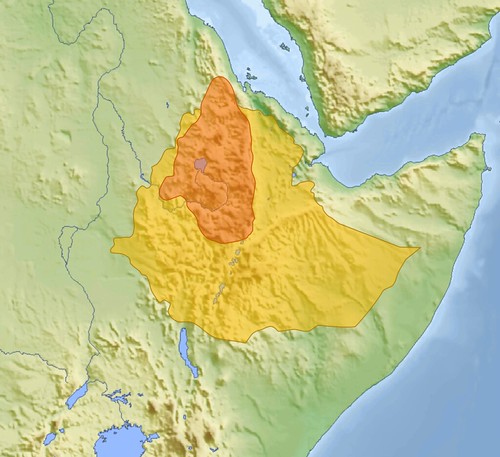 Mara Takla Haymanot overthrows the last ruler of Axumite dynasty, founded by Jewish queen Gudit 40 years before, and starts the Zagwe dynasty, the first dynasty in Empire of Ethiopia
Mara Takla Haymanot overthrows the last ruler of Axumite dynasty, founded by Jewish queen Gudit 40 years before, and starts the Zagwe dynasty, the first dynasty in Empire of Ethiopia -
1150 ± 50The Kebra Negast, an Ethiopian text claiming that the Queen of Sheba came from Ethiopia to see Solomon and that he tricked her into sleeping with him and bearing him a son, appears
-
1197
 Lalibela Cross, a large and elaborately decorated processional cross, is made from one piece of metal in Ethiopia
Lalibela Cross, a large and elaborately decorated processional cross, is made from one piece of metal in Ethiopia -
1270
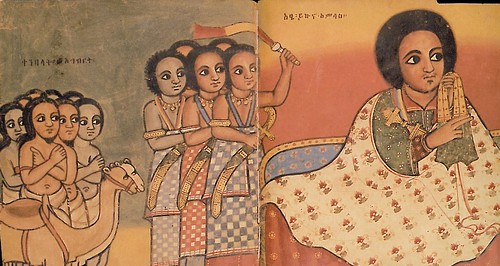 Solomonic dynasty, whose members claimed patrilineal descent from King Solomon of Israel, is founded in Ethiopia by Yekuno Amlak, a member of the Habesha people, from whom Abyssinia gets its name
Solomonic dynasty, whose members claimed patrilineal descent from King Solomon of Israel, is founded in Ethiopia by Yekuno Amlak, a member of the Habesha people, from whom Abyssinia gets its name -
April 9, 1520
 The first European diplomatic mission to Ethiopia, sent by the Portuguese, arrives at Massawa, followed by their arrival at the imperial encampment of Emperor Dawit II in Shewa on 9 October
The first European diplomatic mission to Ethiopia, sent by the Portuguese, arrives at Massawa, followed by their arrival at the imperial encampment of Emperor Dawit II in Shewa on 9 October -
March 9, 1529
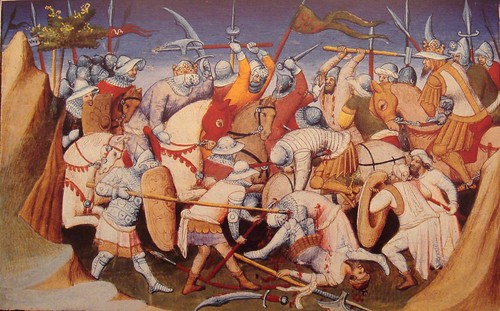 Imam Ahmad Gragn defeats the Ethiopian Emperor Dawit II in the Battle of Shimbra Kure, the opening clash of the Ethiopian–Adal War
Imam Ahmad Gragn defeats the Ethiopian Emperor Dawit II in the Battle of Shimbra Kure, the opening clash of the Ethiopian–Adal War -
1557
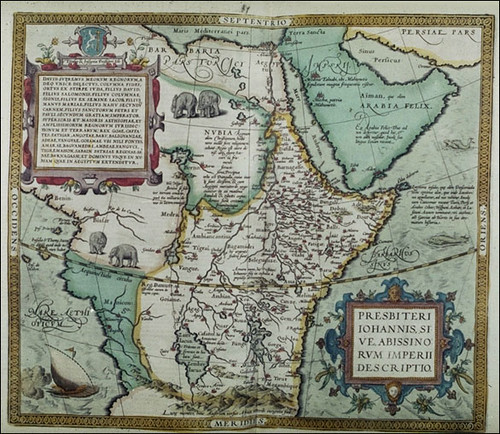 The Ottomans capture Massawa, a city on the Red Sea coast of Eritrea, isolating Ethiopia from the rest of the world
The Ottomans capture Massawa, a city on the Red Sea coast of Eritrea, isolating Ethiopia from the rest of the world -
1636
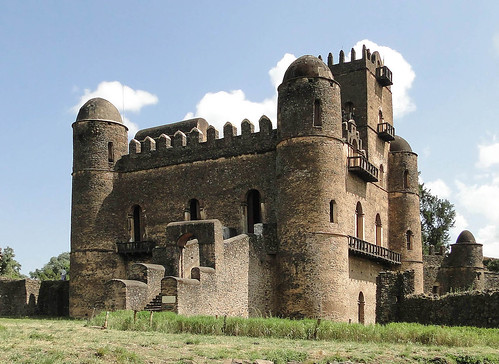 Emperor Fasilides founds the city of Gondar, which becomes the capital of Ethiopia for the next two centuries
Emperor Fasilides founds the city of Gondar, which becomes the capital of Ethiopia for the next two centuries -
May 7, 1769
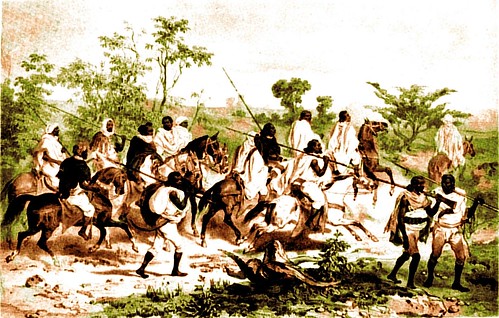 Zemene Mesafint, or Princes era, a period in Ethiopia, when the empire was divided into several regions with no effective central control, begins since the overthrow of Emperor Iyoas
Zemene Mesafint, or Princes era, a period in Ethiopia, when the empire was divided into several regions with no effective central control, begins since the overthrow of Emperor Iyoas -
April 13, 1868
 Tewodros II, Emperor of Ethiopia, commits suicide with a pistol presented him by Queen Victoria at Magdala as the British troops storm the citadel
Tewodros II, Emperor of Ethiopia, commits suicide with a pistol presented him by Queen Victoria at Magdala as the British troops storm the citadel -
January 26, 1887
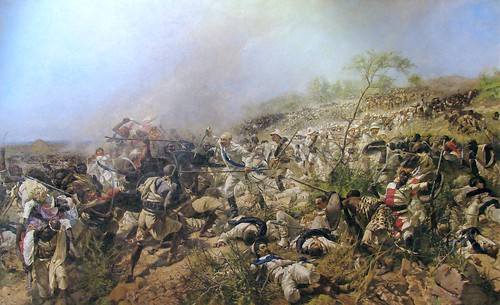 Abyssinian Emperor Yohannes IV defeats Italians in the Battle of Dogali
Abyssinian Emperor Yohannes IV defeats Italians in the Battle of Dogali -
March 10, 1889
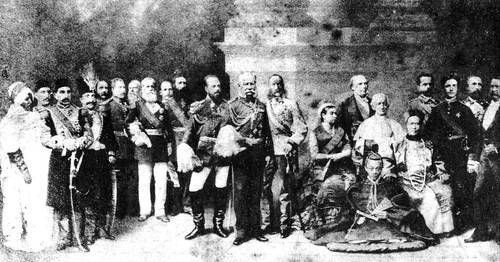 In Ethiopia Emperor Yohannes IV is killed in a war against the dervishes during the Battle of Gallabat
In Ethiopia Emperor Yohannes IV is killed in a war against the dervishes during the Battle of Gallabat -
March 25, 1895
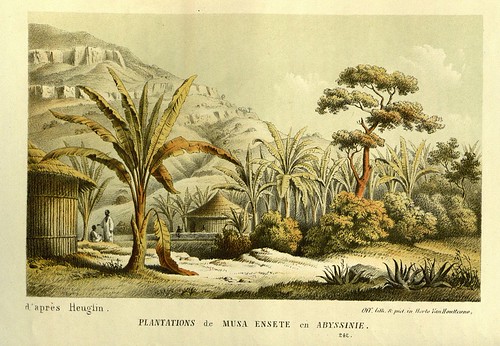 Italian troops invade Abyssinia, starting First Italo-Ethiopian War
Italian troops invade Abyssinia, starting First Italo-Ethiopian War -
December 8, 1895
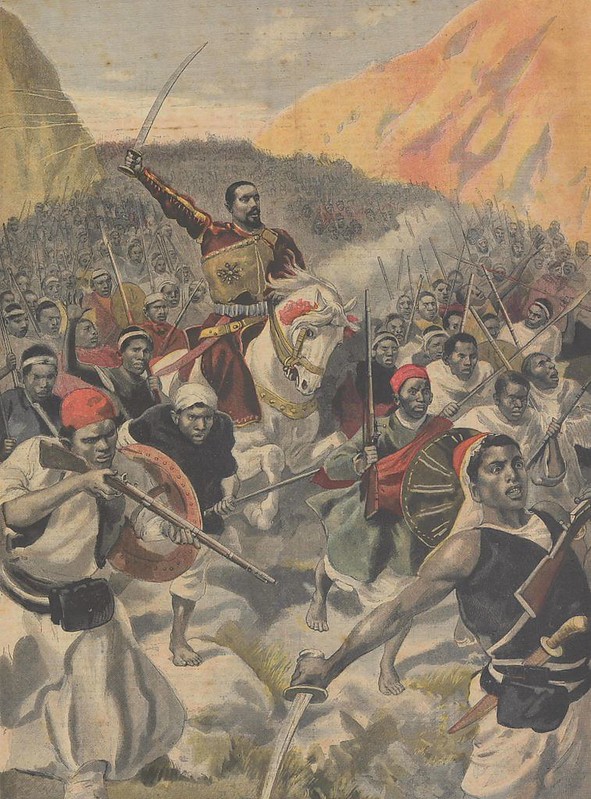 Ethiopian emperor Menelik II drives Italian General Baratieri out in Battle of Amba Alagi during the First Italo–Ethiopian War
Ethiopian emperor Menelik II drives Italian General Baratieri out in Battle of Amba Alagi during the First Italo–Ethiopian War -
March 1, 1896
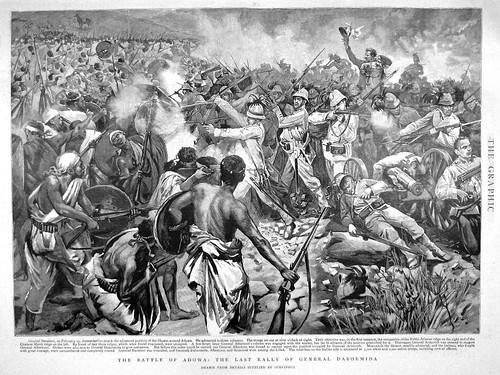 Ethiopia defeats Italy at the Battle of Adwa during the First Italo-Ethiopian War and ensures the first victory of an African state over a European colonial power
Ethiopia defeats Italy at the Battle of Adwa during the First Italo-Ethiopian War and ensures the first victory of an African state over a European colonial power -
November 2, 1930
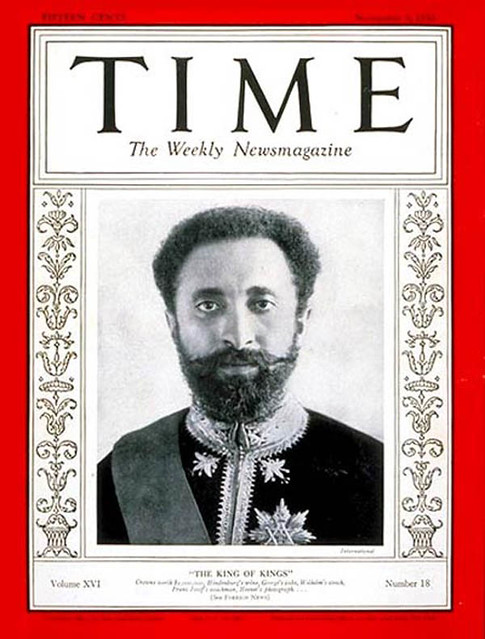 Haile Selassie, a defining figure in both Ethiopian and African history and the messiah in the Rastafari movement, is crowned Haile Selassie I, the 225th emperor of Solmonic Dynasty in Abyssinia
Haile Selassie, a defining figure in both Ethiopian and African history and the messiah in the Rastafari movement, is crowned Haile Selassie I, the 225th emperor of Solmonic Dynasty in Abyssinia -
October 2, 1935
 Italy invades Abyssinia, today Ethiopia, beginning Second Italo-Abyssinian War, which concluded with the exile of Emperor of Ethiopia Haile Selassie and the conquest of Abyssinia by Benito Mussolini
Italy invades Abyssinia, today Ethiopia, beginning Second Italo-Abyssinian War, which concluded with the exile of Emperor of Ethiopia Haile Selassie and the conquest of Abyssinia by Benito Mussolini -
May 9, 1936
 Italy takes Addis Ababa, annexing Abyssinia and incorporates it with Italian Somaliland and Italian Eritrea into the new colony of Italian East Africa
Italy takes Addis Ababa, annexing Abyssinia and incorporates it with Italian Somaliland and Italian Eritrea into the new colony of Italian East Africa -
August 27, 1942
 Emperor Haile Selassie of Ethiopia ends slavery imposing severe penalties, including death, for slave trading
Emperor Haile Selassie of Ethiopia ends slavery imposing severe penalties, including death, for slave trading -
June 26, 1945United Nations Charter, the foundational treaty of the United Nations, is signed by 50 nations in San Francisco, California, United States
-
September 12, 1974
 A Soviet-backed Marxist-Leninist military junta, the "Derg" led by Mengistu Haile Mariam, depose Emperor Haile Selassie and establish communist state known as People's Democratic Republic of Ethiopia
A Soviet-backed Marxist-Leninist military junta, the "Derg" led by Mengistu Haile Mariam, depose Emperor Haile Selassie and establish communist state known as People's Democratic Republic of Ethiopia
Tuesday, February 28, 2017
Today in History
-
This Day in History
 Hello, everyone! We are glad to introduce to you our new project. It is wonderful timeline for this very day. Every day you can read about the best evets that happened in the past. Enjoy reading!/div>
Hello, everyone! We are glad to introduce to you our new project. It is wonderful timeline for this very day. Every day you can read about the best evets that happened in the past. Enjoy reading!/div>
Saturday, February 18, 2017
Minoan Civilization
-
2700 BC
 One of the earliest known civilizations in the Aegean world, the Minoan civilization, rise on the island of Crete beginning the period of flourishing
One of the earliest known civilizations in the Aegean world, the Minoan civilization, rise on the island of Crete beginning the period of flourishing -
2000 BC
 The first palace of Phaistos is built in south central Crete by Minoan civilization
The first palace of Phaistos is built in south central Crete by Minoan civilization -
1900 BC
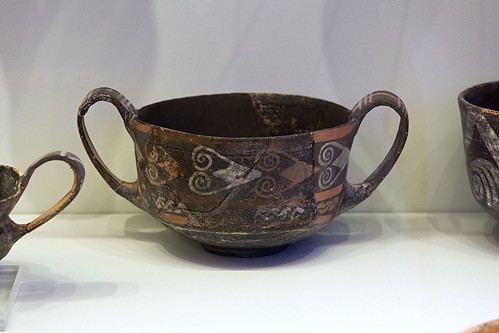 The potter's wheel is introduced in Minoan civilization, making designs of ceramic more free and graceful
The potter's wheel is introduced in Minoan civilization, making designs of ceramic more free and graceful -
1900 BC
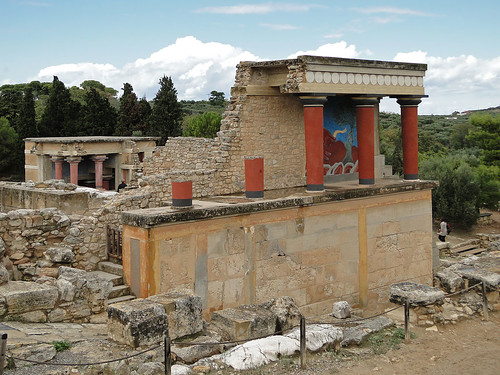 The first palace in the ancient city of Knossos, which considered as Europe's oldest city, is built by Minoan civilization on Crete
The first palace in the ancient city of Knossos, which considered as Europe's oldest city, is built by Minoan civilization on Crete -
1700 BC
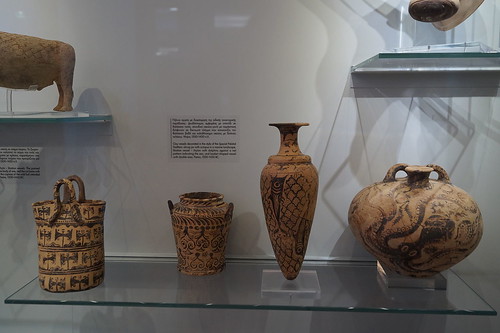 Naturalistic forms such as fish, squid, birds, and lilies in Minoan pottery decoration becomes common
Naturalistic forms such as fish, squid, birds, and lilies in Minoan pottery decoration becomes common -
1627 BCAn eruption of the volcano Thera in the Aegean Sea devastates the island of Thera including the Minoan settlement at Akrotiri and generates 150 m high tsunami that devastates the Minoan coastal settlements on the island of Crete
-
1600 BC
 Bull-Leaping Fresco, a stucco panel on east wall of the palace at Knossos in Crete, a striking example of Minoan Civilization art, is created
Bull-Leaping Fresco, a stucco panel on east wall of the palace at Knossos in Crete, a striking example of Minoan Civilization art, is created -
1600 BC
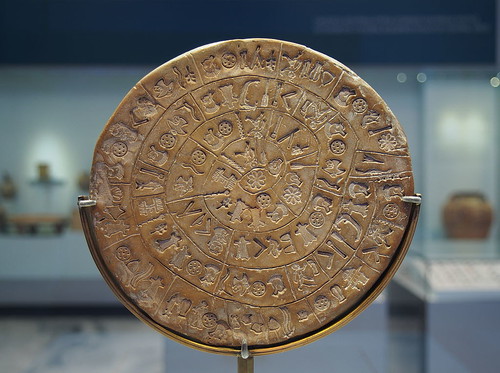 The Phaistos Disc, a disk of terracotta 16 cm in diameter covered on both sides with a spiral of stamped symbols, is made for the Minoan palace of Phaistos on the Greek island of Crete
The Phaistos Disc, a disk of terracotta 16 cm in diameter covered on both sides with a spiral of stamped symbols, is made for the Minoan palace of Phaistos on the Greek island of Crete -
1550 BC
 Rise of Mycenaean Civilization in mainland Greece begins under influences from Minoan Crete
Rise of Mycenaean Civilization in mainland Greece begins under influences from Minoan Crete -
1450 BCMycenaean Greeks conquer and replace Minoan Civilization on Crete
-
1899
 Sir Arthur Evans discovers the center of Minoan civilization on the island of Crete
Sir Arthur Evans discovers the center of Minoan civilization on the island of Crete -
March 16, 1900
 English archaeologist Sir Arthur Evans finds old city of Knossus
English archaeologist Sir Arthur Evans finds old city of Knossus
Labels:
Art,
Arthur Evans,
Bull-Leaping Fresco,
Crete,
Fresco,
History of Greece,
Minoan Civilization,
Minoan Eruption,
Mycenaean Civilization,
Painting,
Palace of Knossos,
Phaistos Disc,
Potter's Wheel,
Pottery,
Tsunami
Sunday, January 8, 2017
Anatomically Modern Human
-
200 Thousand Years Ago
 Anatomically modern human, who has more gracile frames, reduced brow ridges and vertical forehead, evolve from archaic Homo sapiens in East Africa
Anatomically modern human, who has more gracile frames, reduced brow ridges and vertical forehead, evolve from archaic Homo sapiens in East Africa -
70 Thousand Years AgoAnatomically modern humans leave Africa and start colonising the other continents, replacing the Neanderthals in Europe and other hominins in Asia
-
50 Thousand Years AgoHomo sapiens start colonising South Asia, replacing other hominins there
-
40 Thousand Years AgoHomo sapiens migrate to Australia and Europe, replacing the Neanderthals
-
32 Thousand Years Ago
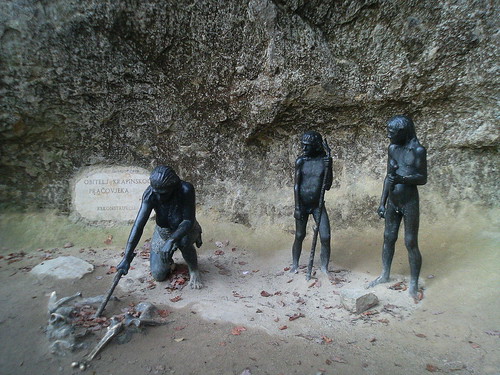 Neanderthals extinct in Europe as a result of competition with modern humans, who moves into their habitat
Neanderthals extinct in Europe as a result of competition with modern humans, who moves into their habitat
Subscribe to:
Posts (Atom)
